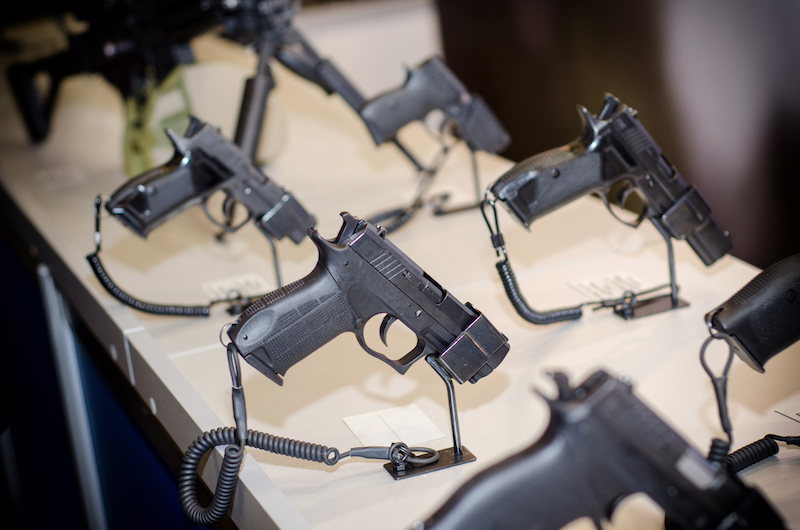
Given the dangers of gun ownership, the firearms industry should be subject to warning label requirements.
Over the last year, Americans have witnessed several of the deadliest mass shootings in the nation’s history. And in the aftermath of each tragedy, public anxiety has intensified as Americans struggled with how best to protect themselves and their families.
One response has been the purchase of more guns. According to David Studdert, a public health expert and professor of law and medicine at Stanford University, the heightened safety and security concerns that follow mass shootings motivate spikes in handgun sales. Yet this increase in gun sales after mass shootings is based on a dangerous misunderstanding of the risks associated with owning a gun.
Admittedly, after gun violence tragedies occur, consumers hear many suggestions urging greater self-defense through gun ownership. For example, at a CNN Town Hall held less than a week after the Parkland shooting, a National Rifle Association (NRA) spokeswoman supported the reaction of law-abiding citizens to purchase guns for protection. She argued against gun control laws because she claimed they will limit the ability of young women and others to defend themselves.
Almost two-thirds of Americans tend to agree, as polls indicate that they believe that owning a gun increases safety. But in fact, the research evidence clearly shows just the opposite: Gun ownership actually puts both the owners and their family members at a greater risk of death.
The mere presence of a gun in a home significantly increases all household members’ risk of a gun-related death due to suicide, homicide, or an accidental shooting. The purported benefits of defensive gun use do not offset the magnitude of this risk. A comprehensive analysis of 626 shootings occurring in three major U.S. cities found that for every time a gun was legally used to kill or injure for self-defense in the home, guns were also used for 11 attempted or completed suicides, seven homicides or criminal assaults, and four accidental shootings.
Suicides constitute two-thirds of annual gun deaths in the United States. Individuals who live in homes with guns are approximately five times more likely to commit suicide by any means and approximately 17 times more likely to commit suicide with a gun than individuals who do not have guns in their homes. Despite these enhanced risks, gun owners and their family members are not more likely to engage in suicidal ideation or planning. This finding indicates that individuals who commit suicide with guns typically do not purchase their guns with the intention of committing suicide.
Suicide usually results from an impulsive decision that can come as a surprise even to the victim. If an individual has access to a gun in a moment of such crisis and attempts suicide with that gun, there is an 85 percent chance of death. But less than 10 percent of people who attempt suicide by any other means actually die. That statistic is why the United States, which possesses almost half of the civilian-owned guns that exist worldwide, suffers from an alarmingly high suicide rate.
The risk of homicide is almost three times higher in homes where guns are present. This risk disproportionately affects female gun owners due to the strong likelihood of their guns being used against them. And the presence of a gun in a domestic violence situation makes it five times more likely that a victim will be killed.
Families with children should be aware that accidental shooting deaths almost always occur in the home. Parents deeply underestimate the danger that having a gun in the home poses to their children. According to a study published in the Journal of the American Medical Association, 39 percent of parents who reported that their children were unaware of the storage location of their gun, and 22 percent of parents who stated that their children never handled their gun, were contradicted by their children’s own reports to the study’s authors.
Gun consumers’ lack of awareness of the severe dangers that stem from gun ownership impairs their ability to make informed decisions on whether they want to bring guns into their homes. The failure of gun manufacturers to provide information about these dangers deprives consumers of their right to balance the risks and benefits of purchasing a gun while taking into account their own personal values, needs, and attitudes toward risk.
When it comes to the risks associated with other products and activities, federal and state regulation protects consumers’ right to self-decision. The law imposes mandatory disclosure requirements on virtually any firm or individual who could pose a risk to consumers: researchers, medical professionals, food and drug manufacturers, and other product manufacturers.
But similar warning requirements have not yet been imposed on gun manufacturers.
Currently, guns are the only consumer product in the United States that is not subject to federal health and safety oversight. When Congress created the Consumer Product Safety Commission (CPSC) under the Consumer Product Safety Act to “protect the public against unreasonable risks of injury associated with consumer products,” it specifically excluded firearms from the CPSC’s jurisdiction.
In light of the research that has revealed the significant dangers associated with gun ownership, it is time for the gun industry to be held to the same standard as all other industries.
The CPSC is well-equipped to regulate the risk information that gun consumers deserve. It can restore their right to self-decision.
Congress must pass legislation to provide the CPSC with authority over guns and to require the Commission to craft mandatory disclosure requirements for guns. Such measures will reduce the information asymmetry in the gun market and provide consumers with the facts they need to make informed decisions that are right for their families.
Until Congress takes action, gun consumers will continue to be surprised by the fact that the very products they believe will protect their families instead put their families at greater risk.
This essay is part of a nine-part series, entitled Bringing Expertise to the Gun Debate.
This essay was based on the author’s article, American Gun Violence: An Information Asymmetry Problem, which is forthcoming in the University of Pennsylvania Journal of Law and Public Affairs.




